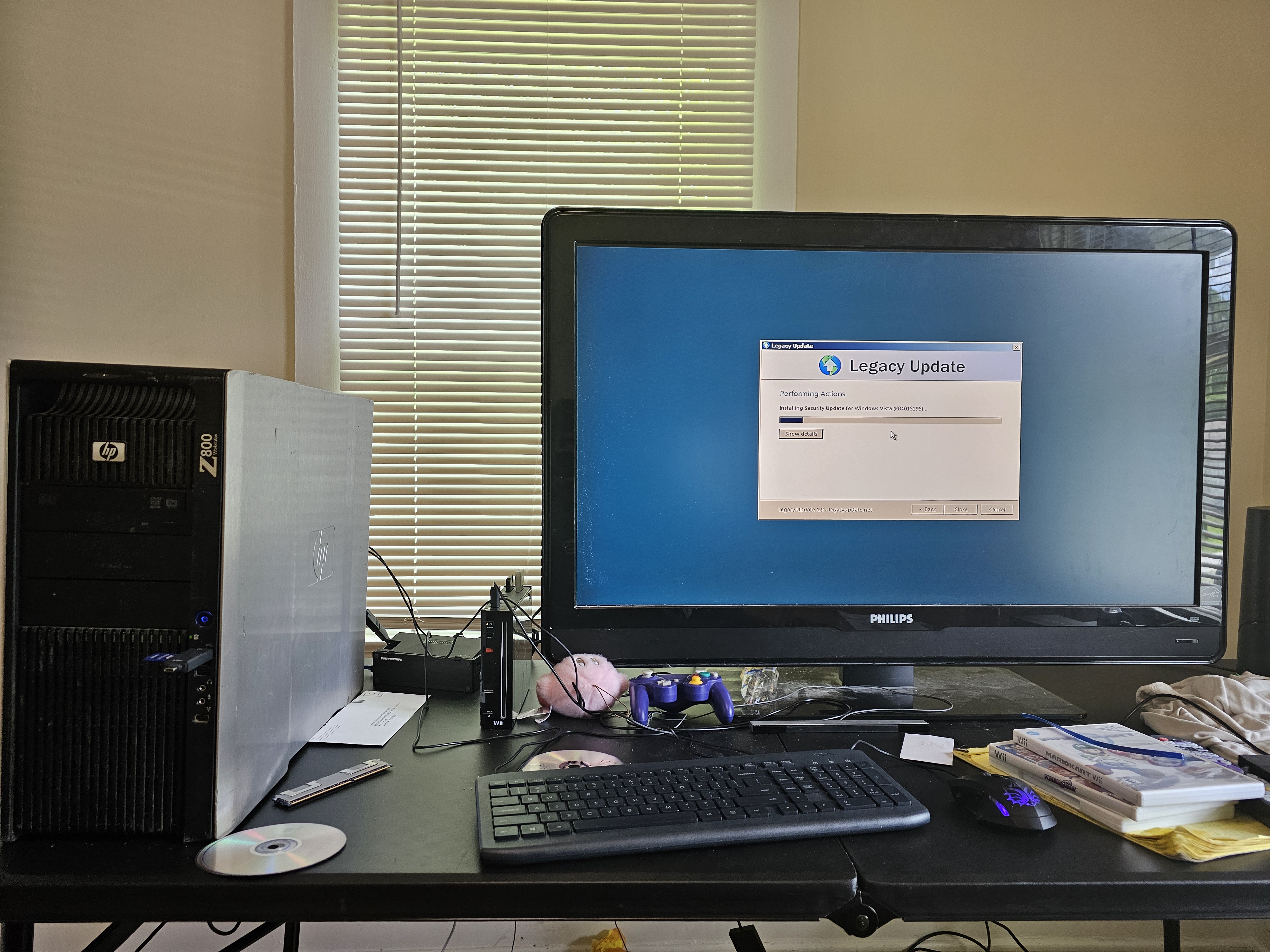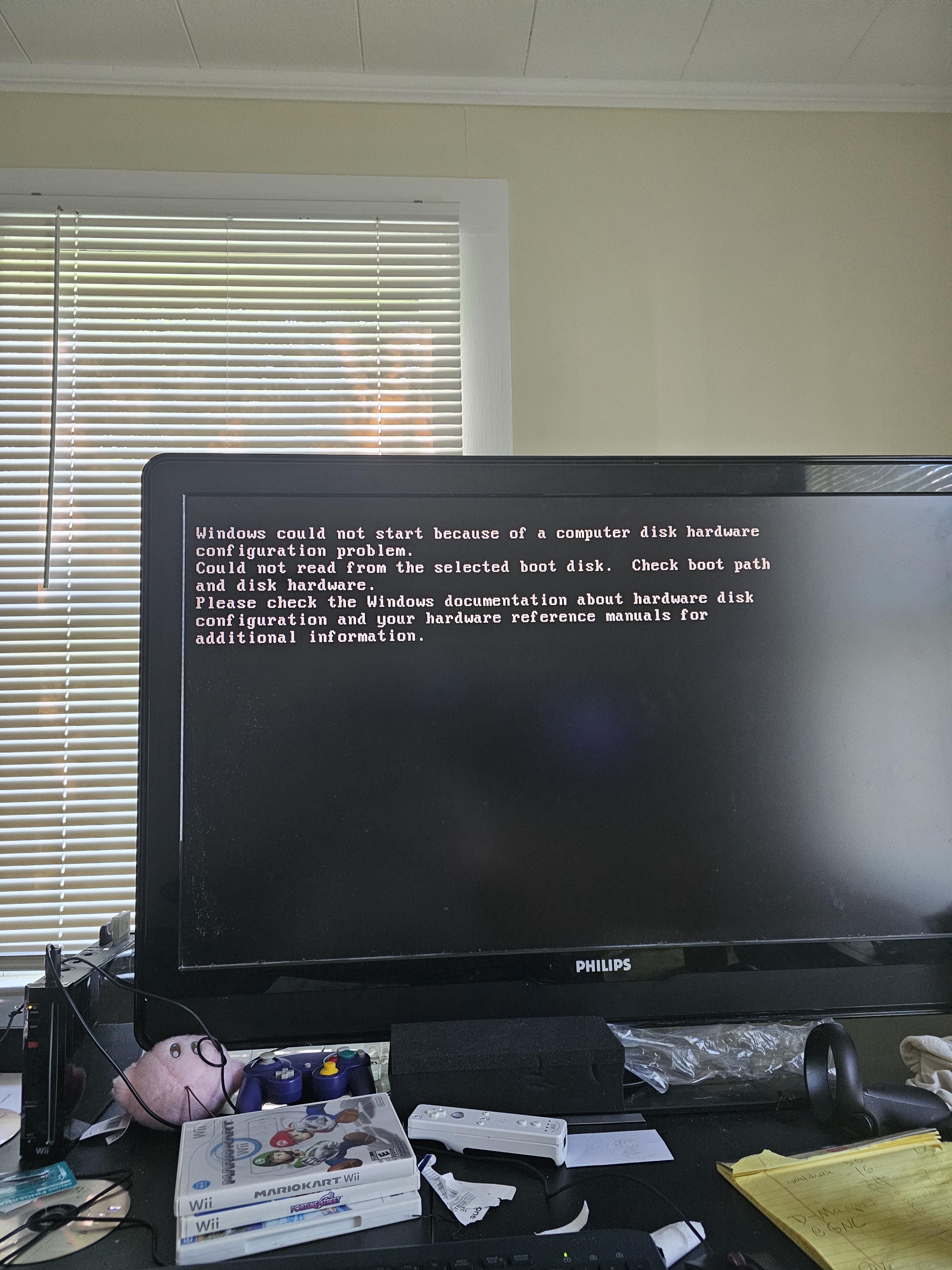#003: Thoughts on the Z800 Workstation
06-23-2024
 If you didn't know, one of my big interests is in old computers, with a focus on computer stuff from the late 90s, 2000s, and early 2010s. Roger, my late father, had always kept a computer running Windows 98 SE that he used to play classic computer games he enjoyed, like Civilization 1, Steel Panthers, Might and Magic VIII, and other such titles.
If you didn't know, one of my big interests is in old computers, with a focus on computer stuff from the late 90s, 2000s, and early 2010s. Roger, my late father, had always kept a computer running Windows 98 SE that he used to play classic computer games he enjoyed, like Civilization 1, Steel Panthers, Might and Magic VIII, and other such titles.
Rather idiotically, I neglected to bring that computer with me when I moved out of the apartment I previously lived at - I think my logic was that there was no space in the place I was staying at while finding a new place to live. That, and it was raining on the move-out day. The apartment company probably sold or scrapped that computer after I turned in the house key, along with all the other crap I left in that place.
To make up for that, I have purchased a few old computers since I moved here. I did bring my daily driver with me, along with a Windows 7 laptop that I had purchased from a thrift store. I had used it to pass time at my old pizza delivery job between deliveries or other tasks. (I could write a few posts talking about that job, to be honest...)
The battery was pretty much dead on the thing when I bought it, and I had it hooked up to a power source at all times. One day, the computer simply would not start up anymore. I moved it to a closet and forgot about it. Some time passed. Suddenly, the computer straight up disappeared, along with its cable. I have no idea what happened to it. Maybe it got stolen (but why would someone steal it? it's more than a decade old, I never used it for anything private/secure, and did not have the battery attached) or maybe I just lost track of it at some point.
After that computer disappeared, I bought an old (Intel) MacBook. It at least had some concept of battery life, being a bit newer than the Windows 7 laptop was. However, as you may know, Apple moved on from Intel chips a long time ago, and Steam was going to be discontinued on those versions. I used the Sierra patcher to allow that version to run on my Intel Mac, but then most of the apps just stopped working. So I stopped using it, outside of writing stuff on it, mostly stories.
Our story picks back up earlier this year. I bought a PC-9821V7 off eBay back in late March, which took a while to arrive from Japan... as well as a bunch of other things that I realized I needed to use the thing in early April, which also took weeks to arrive. After hooking it up, things sorta ran... and I quickly realized that the thing I bought wasn't going to run most of what I wanted because of internal gobbeldy-gook window accelerators. So my focus kind of shifted away from that computer. I haven't touched the computer all that much recently, partially because it's a pain in the neck to put anything on it. The monitor I have hooked up is not exactly compatible with the thing either and has an overscan problem.
A while after that, someone was selling a HP Z800 workstation computer on Facebook Marketplace. They were upgrading their hobby server to a more professional setup and was selling a lot of the parts, including said computer. I drove all the way down to Anderson - roughly two and a half hours away from KurzHQ 3.0 - and then had to wait all day because the seller was at work.
After obtaining said computer, traveling down the still awful construction zone otherwise known as Interstate 85 in South Carolina, and bringing it home, I had a early 2010s computer with 10 terabytes of storage and 96 gigabytes of memory and no clue what to do with it all. My initial ideas, in order of priority: Web server host, multiplayer game server host, something else.
The computer came with a Windows 10 SSD serving as the boot drive, and after picking up some input devices for the thing I started it up. My first task was getting Windows 10 off that drive as soon as possible, because I only use Windows 10 unwillingly and with all the bloatware and junk cleaned off the install.
My first attempt: Windows Server 2008. Installing any pre-Windows 8 OS from disk is still possible, but updates are not possible, at least not without assistance. See, the Windows Update servers only support modern protocols, apparently for security reasons.
Updating older versions of Windows that do not use these protocols out of the box - prior to Windows 8, I believe - just doesn't work anymore. A manual update file from the Windows Update / Microsoft site that is meant to allow the older operating systems to use the modern protocol is available in some cases, but my searches for the corresponding Server '08 update turned up empty.
 So I turned to third-party programs, specifically the "Legacy Update" program. This program handles downloading and installing updates on its own, and as part of the installation does install the protocol update package.
So I turned to third-party programs, specifically the "Legacy Update" program. This program handles downloading and installing updates on its own, and as part of the installation does install the protocol update package.
After the update troubles, it was working fine. For the most part, anyway. My initial goal was to self-host a web server on the computer (which would have hosted this website and blog of mine) using the Windows IIS service... which I only realized after the fact that my ISP would get in the way of doing, so I just abandoned the idea outright. However I was still set on doing this at this point in time.
A couple days passed. Suddenly, the Windows Activation prompt returned. It turns out that installing a Windows Server version is not so simple. These versions require special licenses ("Multiple Activation Key" or MAK licenses), and are clearly meant for businesses. After many failed attempts to bypass the activation requirement and/or obtain a license[1], I more or less gave up on using Server 2008 once I found out about this.
My next attempt was running Windows 7, which this computer originally ran. Installing Win7 went far better, though I did have to go through the external updater rather than fishing for the proper update again. I also had to purchase another key as the edition I installed did not accept the key listed on the case sticker, nor the key I had kept around from my old daily driver. It more or less ran without issues after the beginning.
I then tried to partition the first 1TB ACPI SAS disk (the Windows 7 install was placed on the ex-Windows 10 SSD) and install the "slightly doomed" 64-bit version of Windows XP Professional onto said disk. However, I ran into problems almost immediately. Windows XP, for both 32-bit and 64-bit versions, do not come with support for the ACPI SAS standard by default and would bluescreen with a "Inaccessible Boot Device" error in the installer.
I did find the relevant drivers for the hard drives from the HP website, but they did not work from the "Load a third-party disk driver" menu (which somehow only accepted floppy drives - good thing I had a USB floppy drive and spare disks!) and would also bluescreen with the same error. After switching the BIOS to legacy/non-RAID disk mode, the installer actually ran and I was able to install the OS.
Then, I ran into a second problem: While the secrets of XP's activation logic were figured out a while ago, the resulting key generator simply does not work with 64-bit versions of Windows XP for whatever reason, possibly because 64-bit XP is actually built off of the Windows Server 2003 codebase. Windows XP's online activation servers had also been shut down a long time ago, and the phone activation was either non-functioning at the time or had also been taken offline, as calling it gave me a "Number not in service or disconnected" automated message.
However, after a restart the day after, I lost access to the Windows 7 disk from Windows XP, and I could not boot off of it. This set off a lot of personal panic, worrying that I screwed up the disk in some manner. I proceeded to use Hiren's Boot CD to simply wipe out the XP partition thinking that would let the Windows 7 install carry over. Instead, I got this error message on startup (to left).
It may do good to mention that the CD/DVD drive in the Z800 doesn't always detect disks on bootup, which caused more trouble and made this problem more frustrating than it should have been. But I was able to boot - after about a half dozen attempts across a few days - from the Windows 7 installer disk, and run Startup Repair, which allowed it to boot up again. I can only guess that either the switch from RAID/SAS to PCI (or maybe the switch back to RAID/SAS) in the BIOS, or the install of Windows XP itself, screwed up the boot loader and caused it to break or lose track of the Windows 7 install.
The computer currently just runs Windows 7. I'm still not sure what to do with the computer, given it has so much space and memory... If you have any ideas of what I should do with it, let me know. I'll be happy to try.
[1] - (which failed completely - the system that Server '08 used for purchasing a license is now long gone, and its successor is built into modern Microsoft's Azure product - which clearly has no interest in selling me a singular license for a 15-year-old operating system that went out of support a long time ago)
 If you didn't know, one of my big interests is in old computers, with a focus on computer stuff from the late 90s, 2000s, and early 2010s. Roger, my late father, had always kept a computer running Windows 98 SE that he used to play classic computer games he enjoyed, like Civilization 1, Steel Panthers, Might and Magic VIII, and other such titles.
If you didn't know, one of my big interests is in old computers, with a focus on computer stuff from the late 90s, 2000s, and early 2010s. Roger, my late father, had always kept a computer running Windows 98 SE that he used to play classic computer games he enjoyed, like Civilization 1, Steel Panthers, Might and Magic VIII, and other such titles. So I turned to third-party programs, specifically the "Legacy Update" program. This program handles downloading and installing updates on its own, and as part of the installation does install the protocol update package.
So I turned to third-party programs, specifically the "Legacy Update" program. This program handles downloading and installing updates on its own, and as part of the installation does install the protocol update package.